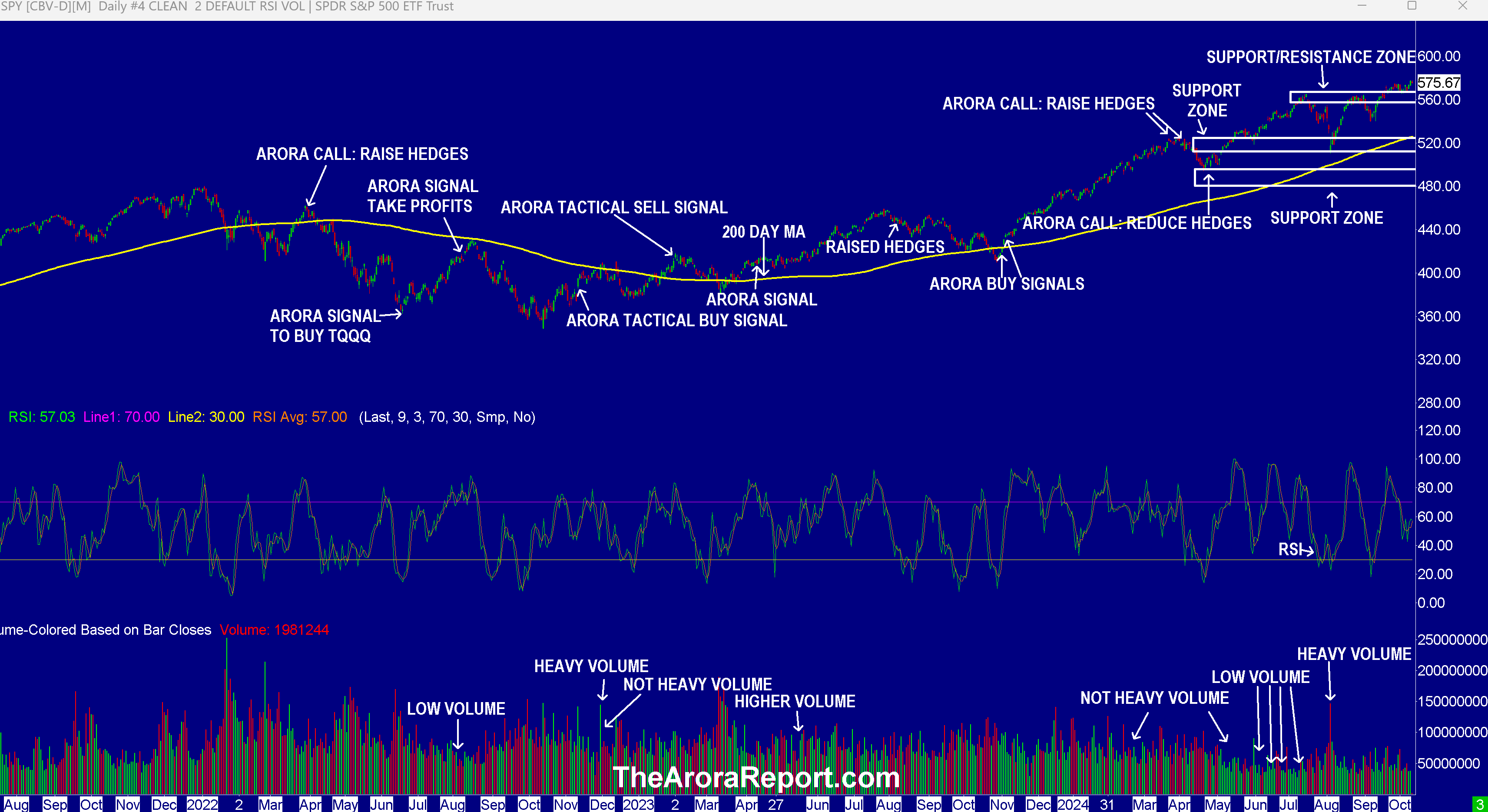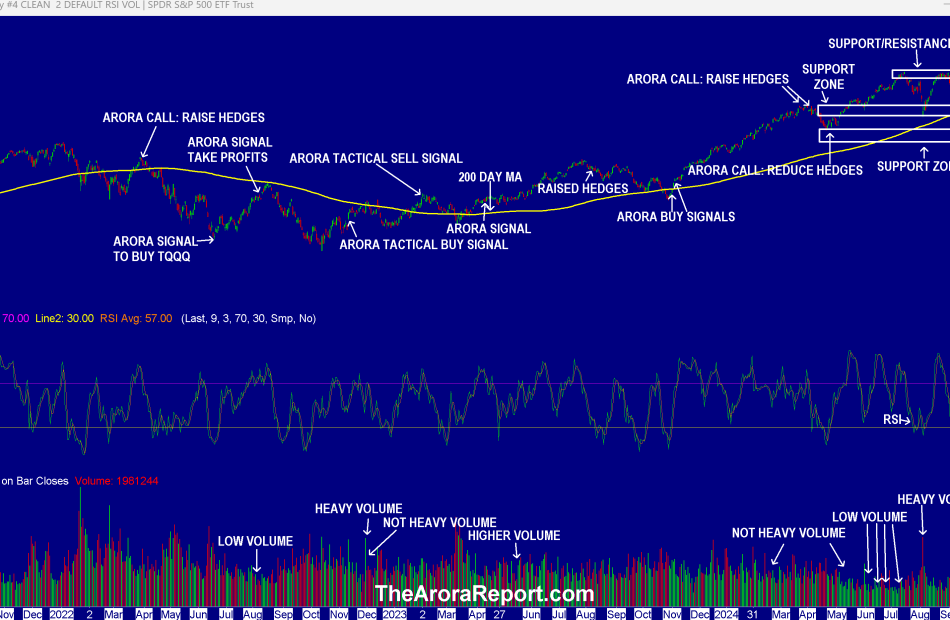Hotter Inflation But Jobless Claims Cushion The Blow – Selling In Nvidia And AI Stocks
To gain an edge, this is what you need to know today.

Hotter Inflation
Please click here for an enlarged chart of SPDR S&P 500 ETF Trust SPY which represents the benchmark stock market index S&P 500 (SPX).
Note the following:
- The chart shows that the stock market made a new high and is above the support/resistance zone.
- The chart shows there is selling this morning after the release of economic data.
- Most troubling for the stock market is that the Consumer Price Index (CPI) came hotter than expected. Of course, as a member of The Arora Report, it is not a surprise to you – we have been writing that inflation may turn out to be stickier compared to what the stock market expects. The reason there is selling on the release of the CPI data is that it is a surprise to the market as whisper numbers were inline with the consensus. Here are the details:
- Headline CPI came at 0.2% vs. 0.1% consensus.
- Core CPI came at 0.3% vs. 0.2% consensus.
- On this CPI data, the market would have been down significantly more than what is shown on the chart because the blow from the hot CPI data is being cushioned by newly released jobless claims data. Initial jobless claims came at 258K vs. 229K consensus. The sharp rise in initial claims goes against the narrative that momo gurus have been using to persuade investors to buy stocks. However, temporarily in the early trade, investors are taking comfort in higher jobless claims believing that it will give ammunition to the Fed to continue cutting rates even if inflation is higher.
- On September 26, we wrote:
Did the Fed make a mistake with the 50 bps cut?
- We have been sharing with you the economic data that indicates the Fed may have made a mistake. In the latest news, we are now finding out that several FOMC members were not in favor of a 50 bps cut. It appears that Powell had to twist arms to push through a 50 bps rate cut.
- FOMC minutes show that there was push back from several members against a 50 bps cut. Several members favored a 25 bps cut. In The Arora Report analysis, based on FOMC minutes, Powell will have difficulty with further large cuts unless economic data changes. This is not discounted in the stock market, and thus, is a risk.
- Later today there is a Treasury auction. The auction results may move the market.
- We have been sharing with you that NVIDIA Corp NVDA has been experiencing a strong rally due to its AI Summit. At a time when the expectations in the stock market are that NVDA stock will move to the resistance zone around $140, after the release of the CPI data, there is selling in NVDA stock. Selling in NVDA stock is bleeding into other AI stocks in the early trade.
- The momo crowd is aggressively buying the dip in the early trade. The momo crowd is especially buying AI stocks.
- Of note is today is Tesla Inc TSLA robotaxi day. TSLA stock has run up in anticipation of Tesla’s CEO Elon Musk saying great things about robotaxis and perhaps robotics and a lower priced Tesla model. Keep a close eye on TSLA stock. If what Musk says exceeds expectations, expect TSLA stock to rally towards $300. On the other hand, if what Musk says is inline with or less than expectations, expect a selloff in TSLA stock. Whatever happens to TSLA stock will bleed into other AI stocks.
Magnificent Seven Money Flows
In the early trade, money flows are positive in Amazon.com, Inc. AMZN and TSLA.
In the early trade, money flows are negative in Apple Inc AAPL, Alphabet Inc Class C GOOG, Meta Platforms Inc META, Microsoft Corp MSFT, and NVDA.
In the early trade, money flows are negative in SPDR S&P 500 ETF Trust and Invesco QQQ Trust Series 1 QQQ.
Momo Crowd And Smart Money In Stocks
Investors can gain an edge by knowing money flows in SPY and QQQ. Investors can get a bigger edge by knowing when smart money is buying stocks, gold, and oil. The most popular ETF for gold is SPDR Gold Trust GLD. The most popular ETF for silver is iShares Silver Trust SLV. The most popular ETF for oil is United States Oil ETF USO.
Bitcoin
Bitcoin BTC/USD is range bound.
Protection Band And What To Do Now
It is important for investors to look ahead and not in the rearview mirror.
Consider continuing to hold good, very long term, existing positions. Based on individual risk preference, consider a protection band consisting of cash or Treasury bills or short-term tactical trades as well as short to medium term hedges and short term hedges. This is a good way to protect yourself and participate in the upside at the same time.
You can determine your protection bands by adding cash to hedges. The high band of the protection is appropriate for those who are older or conservative. The low band of the protection is appropriate for those who are younger or aggressive. If you do not hedge, the total cash level should be more than stated above but significantly less than cash plus hedges.
A protection band of 0% would be very bullish and would indicate full investment with 0% in cash. A protection band of 100% would be very bearish and would indicate a need for aggressive protection with cash and hedges or aggressive short selling.
It is worth reminding that you cannot take advantage of new upcoming opportunities if you are not holding enough cash. When adjusting hedge levels, consider adjusting partial stop quantities for stock positions (non ETF); consider using wider stops on remaining quantities and also allowing more room for high beta stocks. High beta stocks are the ones that move more than the market.
Traditional 60/40 Portfolio
Probability based risk reward adjusted for inflation does not favor long duration strategic bond allocation at this time.
Those who want to stick to traditional 60% allocation to stocks and 40% to bonds may consider focusing on only high quality bonds and bonds of five year duration or less. Those willing to bring sophistication to their investing may consider using bond ETFs as tactical positions and not strategic positions at this time.
The Arora Report is known for its accurate calls. The Arora Report correctly called the big artificial intelligence rally before anyone else, the new bull market of 2023, the bear market of 2022, new stock market highs right after the virus low in 2020, the virus drop in 2020, the DJIA rally to 30,000 when it was trading at 16,000, the start of a mega bull market in 2009, and the financial crash of 2008. Please click here to sign up for a free forever Generate Wealth Newsletter.
Market News and Data brought to you by Benzinga APIs
© 2024 Benzinga.com. Benzinga does not provide investment advice. All rights reserved.


Leave a Reply